|
|


Emergency Alert Systems
 This section of our technical library presents articles written about Emergency Alert Systems and Disaster Recovery definitions, terms and related information.
This section of our technical library presents articles written about Emergency Alert Systems and Disaster Recovery definitions, terms and related information.
The 911Broadcast emergency notification and alert service can deliver a large number of phone calls using a network of phone systems employing digital phone lines simultaneously. Should a disaster such as a snow storm, wild fire or flood hit your area, 911Broadcast systems can alert your community quickly providing specific instructions if an evacuation is required.
This service is available using our emergency broadcasting systems. If a dangerous chemical spill occurs in your community, you can target specific areas to call. If a severe snow storm hits your area, your community can be notified of school closings or event cancellations.
The Emergency Alert System (EAS)
From: www.fcc.gov
History
"This is a test of the Emergency Alert System—this is only a test…"
You will occasionally hear or see these words on your local broadcast station or cable system.
In 1951, President Harry Truman established CONELRAD (Control of Electromagnetic Radiation) as the first national alerting system. Under CONELRAD, radio stations were required to broadcast only on certain frequencies during an emergency alert. This prevented an enemy from attacking by using transmissions from broadcast stations as a guide for their target.
CONELRAD later became the "Emergency Broadcast System" (EBS). The EBS was designed to provide the President with a means to address the American people in the event of a national emergency. Through the EBS, the President had access to thousands of broadcast stations to send an emergency message to the public.
In 1994, to overcome some of the limitations of the older EBS system, the Federal Communications Commission (FCC) replaced the EBS with the Emergency Alert System (EAS). The major difference between EBS and EAS is the method used to alert broadcast stations about an incoming message.
The EAS provides not only the President, but national, state and local authorities, with the ability to give emergency information to the general public via broadcast stations, cable and wireless cable systems. While participation in national EAS alerts is mandatory for these providers, state and local area EAS participation is voluntary.
The FCC and EAS
The FCC designed the EAS in cooperation with the National Weather Service (NWS) and the Federal Emergency Management Agency (FEMA). Each of these agencies plays an important role. The FCC provides information to broadcasters, cable system operators, and other participants in the EAS regarding the technical and operational requirements of the EAS. Additionally, the FCC ensures that state and local EAS plans conform to the FCC’s rules and regulations. The NWS provides emergency weather information to alert the public about dangerous conditions. FEMA provides direction for state and local emergency planning officials to plan and implement their roles in the EAS.
The EAS uses state-of-the-art digital technology to distribute messages. The system provides state and local officials with a method to quickly send out important local emergency information targeted to a specific area. Also, the EAS digital signal is the same signal that the National Weather Service (NWS) uses on the National Oceanic and Atmospheric Administration’s Weather Radio (NWR). This allows NWR signals to be decoded by the EAS equipment at broadcast stations and cable systems. Broadcasters and cable operators can then send NWS weather warning messages almost immediately to their audiences.
EAS allows broadcast stations, cable systems, participating satellite companies, and other services to send and receive emergency information quickly and automatically, even if these facilities are unattended. EAS was designed so that if one link in the dissemination of alert information is broken, the entire system does not fail. EAS also automatically converts to any language used by the broadcast station or cable system.
Also, specially equipped consumer products, such as televisions, radios, pagers and other devices, can decode EAS messages. Consumers can program these products to "turn themselves on" for the messages they want to receive.
Finally in 1997, EAS replaced the weekly (on-air) "only a test" broadcast notifications used by the EBS with less obtrusive weekly internal tests and monthly on-air tests. All AM, FM, and TV broadcast stations, as well as cable systems, with 10,000 or more subscribers, use these procedures.
The ultimate goal of the EAS is to disseminate emergency information as quickly as possible to the people who need it.
To receive information on this and other FCC consumer topics through the
Commission’s electronic subscriber service, click on www.fcc.gov/cgb/emailservice.html.
Our Service Is Activated Online Or By Phone
 The 911 emergency broadcast service is easy to install and use. We help you collect community call lists and organize them in a fashion that best fits your emergency broadcast requirements. When an emergency arises, you simply record your emergency message offline or use our toll free phone service to record your message.
Next identify your call recipients using a simple list manager or a graphical map display and send us your phone numbers via the internet. You can also identify pre-defined lists to call using simple touchphone responses on our toll free service. We do the rest.
Unlike some systems that are limited by the number of lines available to perform this emergency dialing, our service is provided to you using a network of thousands of phone lines that can deliver your emergency messages much faster.
Our emergency notification system delivers messages to individuals or answering machines and can even allow the call recipient to make touchphone selections. This may be critical if your response center requires a positive acknowledgement from the call recipient.
The 911 emergency broadcast service is easy to install and use. We help you collect community call lists and organize them in a fashion that best fits your emergency broadcast requirements. When an emergency arises, you simply record your emergency message offline or use our toll free phone service to record your message.
Next identify your call recipients using a simple list manager or a graphical map display and send us your phone numbers via the internet. You can also identify pre-defined lists to call using simple touchphone responses on our toll free service. We do the rest.
Unlike some systems that are limited by the number of lines available to perform this emergency dialing, our service is provided to you using a network of thousands of phone lines that can deliver your emergency messages much faster.
Our emergency notification system delivers messages to individuals or answering machines and can even allow the call recipient to make touchphone selections. This may be critical if your response center requires a positive acknowledgement from the call recipient.
Purchase Or Outsource?
This is a question that communities should carefully consider. A purchased system gives you more control, but requires sufficient phone lines, equipment and on site technical knowledge to keep your system operational. The larger your community, the greater capital expense is required to broadcast your emergency messages in a timely fashion. If your message broadcasting system is used for more than just emergencies, it is easier to justify a purchase over contracted service. After all, emergency phone broadcasting is something you hope you never need to use.
Contracting your emergency broadcasting service requires less up front capital and can provide a faster emergency broadcast response if your provider has the resources available. Other than a monthly subscription fee, you only pay for the emergency broadcast as it occurs. System redundancy is available as well as centralized and experienced technical assistance.
|




 This section of our technical library presents articles written about Emergency Alert Systems and Disaster Recovery definitions, terms and related information.
This section of our technical library presents articles written about Emergency Alert Systems and Disaster Recovery definitions, terms and related information.
 The 911 emergency broadcast service is easy to install and use. We help you collect community call lists and organize them in a fashion that best fits your emergency broadcast requirements. When an emergency arises, you simply record your emergency message offline or use our toll free phone service to record your message.
Next identify your call recipients using a simple list manager or a graphical map display and send us your phone numbers via the internet. You can also identify pre-defined lists to call using simple touchphone responses on our toll free service. We do the rest.
Unlike some systems that are limited by the number of lines available to perform this emergency dialing, our service is provided to you using a network of thousands of phone lines that can deliver your emergency messages much faster.
Our emergency notification system delivers messages to individuals or answering machines and can even allow the call recipient to make touchphone selections. This may be critical if your response center requires a positive acknowledgement from the call recipient.
The 911 emergency broadcast service is easy to install and use. We help you collect community call lists and organize them in a fashion that best fits your emergency broadcast requirements. When an emergency arises, you simply record your emergency message offline or use our toll free phone service to record your message.
Next identify your call recipients using a simple list manager or a graphical map display and send us your phone numbers via the internet. You can also identify pre-defined lists to call using simple touchphone responses on our toll free service. We do the rest.
Unlike some systems that are limited by the number of lines available to perform this emergency dialing, our service is provided to you using a network of thousands of phone lines that can deliver your emergency messages much faster.
Our emergency notification system delivers messages to individuals or answering machines and can even allow the call recipient to make touchphone selections. This may be critical if your response center requires a positive acknowledgement from the call recipient.